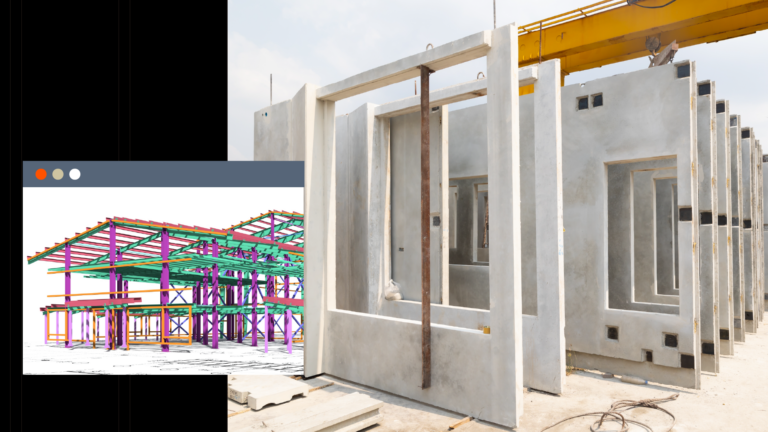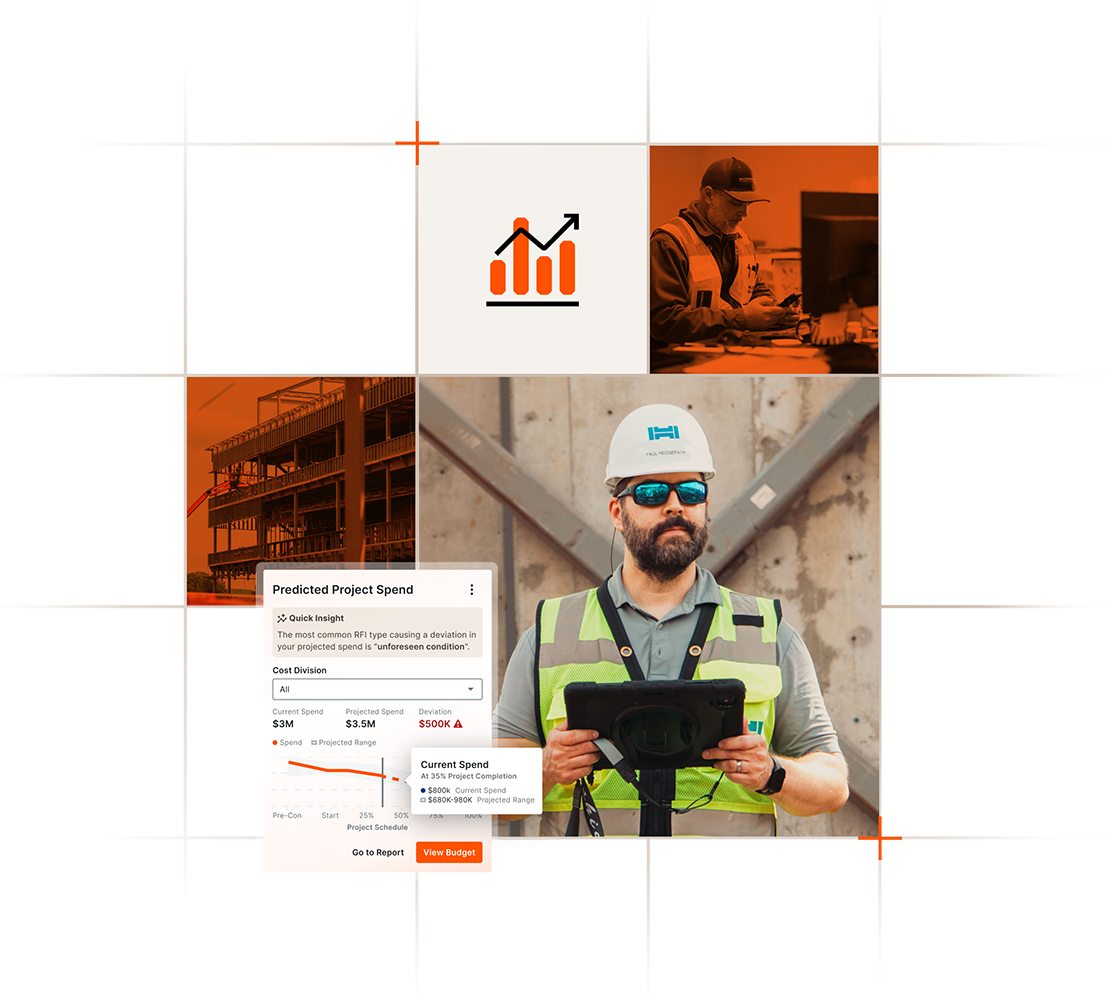— 9 min read
BIM and Prefabrication: Fine-Tuning Construction Techniques


Last Updated Oct 3, 2025

DJ Phipps
Senior Principal Strategic Product Consultant
16 articles
DJ Phipps has spent over two decades working in the building and design industry. He's dedicated to using technology to make work easier and more efficient, with a focus on project management and improving systems. DJ now plays a key role at Procore as a Senior Principal Strategic Product Consultant.

Kacie Goff
Contributing Writer
87 articles
Kacie Goff is a construction writer who grew up in a construction family — her dad owned a concrete company. Over the last decade, she’s blended that experience with her writing expertise to create content for the Construction Progress Coalition, Newsweek, CNET, and others. She founded and runs her own agency, Jot Content, from her home in Ventura, California.
Last Updated Oct 3, 2025

Prefabrication — or the offsite assembly of a component — is by no means new in construction. Creating elements offsite can allow for faster production and easier installation. In a time when construction schedules are shortening, this delivers much-needed support for the project’s timeline.
The trick, though, is making sure that the prefabricated element will fit and properly connect when brought to the jobsite. Building information modeling (BIM) delivers the detailed level of spatial coordination needed here. As a result, when contractors decide to prefabricate, they increasingly turn to BIM.
Table of contents
Historical Challenges With Prefabrication
In preparation for the 1968 HemisFair, entire hotel rooms were prefabricated offsite, allowing the Hilton Palacio del Rio to be erected in just 202 days. While that’s a fairly extreme example, most construction projects have some prefabricated elements in them. Roof trusses and structural steel are just a couple of examples.
Teams undertaking prefabrication often operate under the assumption that everything’s going to be built per the contract documentation. In reality, though, what happens in the field might not precisely mirror what’s captured in the drawings and specifications.
This doesn’t necessarily mean that something was done in error, either. Different systems have different tolerances. Tolerances are a standardized, accepted part of construction. But the ±1/2 inch of tolerance for concrete could be big enough that a prefabricated system doesn’t fit when it’s brought in for installation.
Then, teams are tasked with finding ways to make it work. The quality of the prefabbed element may need to be compromised in order for it to be installed. Otherwise, fixing the issue might introduce delays or even rework.
Because of all of these potential problems, some teams see prefabrication as risky. The issue isn’t actually with prefab, though. It’s with the coordination effort undertaken to make sure what’s assembled offsite will fit and function as intended.
Using BIM for Prefabrication
Prefabrication is one of the most beneficial byproducts of the thorough coordination that comes from building information modeling (BIM).
BIM delivers a 3D model that stakeholders can use for a variety of purposes, the most widely discussed of which is a form of spatial coordination called clash detection. Creating a constructible three-dimensional model (or validating it, if it comes from an external source like the design team) is a spatial coordination effort. This helps stakeholders see how the pieces of the puzzle that is the project will come together.
The bigger those pieces are, the more quickly everything can come to life. Enter: prefabrication. BIM helps here in a few ways.
For starters, BIM allows spatial coordination in all three dimensions at once, helping stakeholders best plan for the placement and connection of prefabbed components.
Just as importantly, though, BIM helps them thoroughly visualize what will go on around that prefabricated element. As a result, they’re better able to plan for any deviations from the contract documents, whether due to accepted tolerances or otherwise.
Because of this, BIM is commonly used to support prefabrication of a wide range of project elements, including:
- Fire protection systems
- Metal framing
- Exterior wall systems, including doors and curtain walls
- Structural steel
- Precast concrete
- Mass timber
A Workflow for BIM-Supported Prefabrication
Other than self-performing general contractors (GCs), specialty contractors do the work of prefabrication. In doing so, they usually follow a process that loosely mirrors the following timeline.
u003cstrongu003eModel Release or Creationu003c/strongu003e
Once the project reaches a specific coordination milestone or set of milestones, the trade contractor might get the model from the design team or the GC. They might also choose to create their own, using the drawings from the contract documents, to make sure they have the level of accuracy they need.
Validation through Submittals
The trade contractor’s model usually gets sliced into 2D drawings which are sent to the engineer of record for submittal review. Once reviewed and approved, those drawings — and the associated model — help the trade contractor decide how to move forward.
u003cstrongu003eIdentification of Elements for Prefabricationu003c/strongu003e
The specialty contractor decides which components they want to prefabricate. For piping, conduit and ductwork, this prefabrication effort is called spooling.
u003cstrongu003eDrawings Sent to the Fabrication Shopu003c/strongu003e
In most cases, the fab shop doesn’t get the model. Instead, they get 2D drawings sliced from the model. Some software solutions can push drawings straight from the model to the fabrication shop. As prefab equipment like computer numerical control (CNC) machines get more sophisticated, the model can sometimes be directly uploaded there, too.
u003cstrongu003ePrefabricationu003c/strongu003e
The team in the shop creates the element per the provided drawings or model. They may also perform quality control testing as part of this fabrication effort. A section of ductwork might be capped and pressure-tested in the shop, for example.
u003cstrongu003eInstallation on the Jobsiteu003c/strongu003e
Once the element is ready, it’s delivered to the jobsite. Sometimes, the contractor attaches something to denote where it should be installed. They might put a sticker on the element with a QR code that pulls up the element in the model, for example. Ideally, backed by the thorough spatial coordination that is BIM, that installation goes quickly and easily.
Level of Detail (LOD) in BIM for Prefab
The greater the level of detail (LOD) in the model, the easier it is to coordinate prefabrication. Big industry players like the Associated General Contractors of America (AGC) and the American Institute of Architects (AIA) have come together in an attempt to standardize that LOD. (Even so, how LOD is used and what the number attached signifies often ranges.)
Most companies primarily work with LOD 300–500, with LOD 500 signifying the as-built model.
At LOD 300, BIM elements have dimensions and clearance zones have been identified. For some prefab work, this is enough.
Other types of prefabrication might require more granular detail. At LOD 350, connections are more fully fleshed out, which can be helpful for the fit and function of the prefabbed element. 400 is widely accepted as a fabrication-ready LOD.
Specialty contractors need to determine what LOD is required for the specific kind of prefabrication they plan to undertake.
Prefabrication vs. Modularization
As a quick aside, some construction professionals use the terms “prefabrication” and “modularization” interchangeably to refer to assembly that happens offsite. Modularization, though, entails larger-scale deliverables. Rather than assembling a single system offsite, teams might assemble entire rooms.
The Hilton Palacio del Rio mentioned above technically used modularization. Bathroom pods modularized to be installed at hospitals provide another example here.
This article explores prefabrication, but the requirement for strong coordination grows with the scale of the project. BIM supports modularization in the same ways it supports prefab.
The Benefits of Using BIM for Prefab
When teams use building information modeling to thoroughly plan for prefabricated elements, it yields benefits.
Higher-quality Assemblies
The model helps teams precisely plan what needs to be fabricated. Then, teams get to create components in a dedicated environment. They should have all the tools they need at the ready, and they don’t have to move around other teams and materials as they work.
Plus, they can test assemblies for quality before bringing them to the jobsite. And because the assembly was coordinated in the model, it should fit precisely when brought in for install. That limits the need for any unexpected adjustments that could interfere with its quality.
In some cases, the model can be fed to equipment that automates some of the prefabrication, like a CNC machine or a 3D printer.
Safer Work Environments
A fabrication shop allows workers to create components in the way that’s safest for them. Instead of installing individual sections of ductwork at heights, for example, teams in the shop can assemble racks at the ground. This reduces the risk of a fall and increases the ergonomics of their work.
Schedule Adherence — or Even Acceleration
With solid planning in place thanks to the BIM model, teams can move the project forward quickly. One trade contractor could be on site, installing their portion of the work in the space, while another contractor’s team develops elements needed for that same area offsite in their prefab shop.
Prefabrication helps to eliminate some of the delays introduced as one contractor waits for the previous contractor’s install to be completed. Teams can work faster and simultaneously, helping the project stay on or even ahead of schedule.
Smoother Collaboration Among Contractors
Historically, whatever was already installed on the jobsite took precedence. Whatever came next usually needed to work with — or around — what was in place. This discouraged prefabrication because contractors wanted their work to be the priority, and that meant installing as soon as possible.
Thanks to BIM, and specifically clash detection, projects can be planned so that no matter when each contractor installs their work, everything fits seamlessly together.
Free AI in Construction Course with Hugh Seaton
Start learning today with industry expert Hugh Seaton and discover how AI can boost efficiency, reduce risk, and transform your projects.

Overcoming Challenges When Using BIM for Prefab
The biggest issue with prefabrication — the prefabbed element’s improper fit or function when brought to the jobsite — doesn’t necessarily change with BIM. The model should help to solve this challenge, but for that to happen, the model needs to be accurate.
As a result, users need to make sure they have the appropriate level of detail, and that the model aligns with contract documents. In fact, some contractors even create their own models from the contract documents rather than trusting the provided model.
Beyond that, the prefabricating contractor needs to solve the logistics piece. If they prefabricate a 20-foot section of ductwork for the seventh floor of a project, they need to have a plan to get that up to the appropriate floor. Can it fit in the elevator shaft? Can it be craned in through a window? The entire sequence of installation needs to be planned, including how the element will be moved from the fab shop to the install location.
Finally, communication gets particularly important with prefabrication. If elements are being prefabricated offsite, stakeholders (particularly the owner) may start to worry that visible progress isn’t being made on the jobsite. As a result, it helps to keep all stakeholders apprised of offsite activities.
With a trustworthy and detailed model, good coordination for the prefabbed element’s install and solid communication, BIM supports effective prefabrication. As a result, modeling allows for faster, safer, higher-quality progress toward the desired project outcomes.
NOV 6, 2025 at 11:00 AM PST / 2:00 PM EST
Free Webinar: Prove your project management software is profitable
Join Procore and Dodge Data & Analytics for a 2025 Dodge ROI Report deep dive.

Was this article helpful?
Thank you for your submission.
0%
0%
You voted that this article was . Was this a mistake? If so, change your vote
Scroll less, learn more about construction.
Subscribe to The Blueprint, Procore’s construction newsletter, to get content from industry experts delivered straight to your inbox.
By clicking this button, you agree to our Privacy Notice and Terms of Service.
Thank you!
You’re signed up to receive The Blueprint newsletter from Procore. You can unsubscribe at any time.
Categories:
Written by

DJ Phipps
Senior Principal Strategic Product Consultant | Procore Technologies
16 articles
DJ Phipps has spent over two decades working in the building and design industry. He's dedicated to using technology to make work easier and more efficient, with a focus on project management and improving systems. DJ now plays a key role at Procore as a Senior Principal Strategic Product Consultant.
View profile
Kacie Goff
Contributing Writer | Procore Technologies
87 articles
Kacie Goff is a construction writer who grew up in a construction family — her dad owned a concrete company. Over the last decade, she’s blended that experience with her writing expertise to create content for the Construction Progress Coalition, Newsweek, CNET, and others. She founded and runs her own agency, Jot Content, from her home in Ventura, California.
View profileExplore more helpful resources

How Are Partnerships in Construction Being Redefined?
In a market where cost, speed, and quality are table stakes, owners are demanding more than projects delivered on time and on budget. They want trusted partners who bring strategy,...

How Close Are We to Bridging the Design-Build Divide?
For decades, construction decisions have often been made based on gut instinct. But what if the real barrier to transformation isn’t technology—it’s the divide between design and construction? In episode...

Will AI Replace ‘Paperless Builders’—or Redefine Them?
How can artificial intelligence enhance rather than replace human expertise in construction? In Episode 16, Hamzah Shanbari, Director of Innovation at Haskell and author of “The Paperless Builders,” reveals how...

Building Intelligence: How AI & Data Are Rewiring Construction for the Digital Age
As data center construction surges to meet the demands of AI, cloud computing, weekend streaming binges and real-time digital services, the pressure being put on builders by owners has reached...
Free Tools
Calculators
Use our calculators to estimate the cost of construction materials for your next project.
Templates
Find a template to help you with your construction project tasks.
Material Price Tracker
Get the latest U.S. retail prices and view historical trends for common building materials.
Glossary
Explore key terms and phrases used in the industry.
